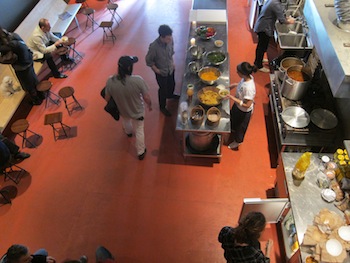Rare is the occasion when people talk about food in art without someone uttering (or at least thinking) the name Rirkrit Tiravanija. Known as “the artist who cooks,” Tiravanija began to eschew objects in favor of ingestion in 1990 with his installation-slash-performance Pad Thai, for which he cooked and served the dish to visitors of Paula Allen Gallery in New York. Two years later, he created Untitled (Free), a makeshift kitchen featuring the artist’s Thai curry, self-served by gallery-goers day after day. Tiravanija’s latest installation Fear Eats the Soul at Gavin Brown’s Enterprise serves up bowls of soup every Thursday, Friday, and Saturday through April 16. Like an open invitation to dine at a world famous restaurant free of charge, you would be a fool not to take advantage of this opportunity if you’re in New York.
Rirkrit Tiravanija, "Fear Eats the Soul (Chicken Tortilla Soup )," 2011. Courtesy Gavin Brown's Enterprise.
On the Friday afternoon that I visited Tiravanija’s soup kitchen, it had the feeling of a friendly neighborhood eatery; I was surprised to be greeted by other visitors upon entering the space. “Would you like a bowl of soup?” asked Tiravanija’s assistant and quickly I accepted. While I selected condiments for my soup, New York magazine’s senior art critic Jerry Saltz introduced himself, recommended a squeeze of lime, and shared his reasons for passing on cilantro. Three or so spoonfuls later, I realized two things: one, Saltz was right about that delightful zing of lime; and two, in my eagerness to try the artist’s cooking, I had failed to ask if the soup was vegetarian! Not only was it made of chicken broth, but my spoon had yet to encounter Peep-sized chunks of meat in this thick brown abyss–also known as Chicken Tortilla Soup. On one hand, I was saddened that my diet would keep me from having the full “Tiravanija experience.” On the other hand, I knew that the soup was just a catalyst for social interaction. I settled for tortilla chips and art world chatter.
Since the 1990s, Tiravanija has been something of a poster child for “relational aesthetics,” a term coined by art critic and curator Nicolas Bourriaud. (Art21 writer Meredith C. MacKenzie has written about the term at length). If anything, Tiravanija’s soup kitchen attests to the limitations of this ideological box. Where cooking and eating turn the exhibition space into a convivial setting, one in which people might relate to the artist and to each other, niche artspeak such as relational aesthetics is the discourse of few and serves to create walls. That Tiravanija has chosen to focus on soup, a universal dish that appears in nearly every cuisine in the world; set up areas for communal eating; and opened the gallery to the street, thereby collapsing public and private space, signifies his (ongoing) effort to create and widen channels of communication. But then this soup is being dished out in a gallery in the monied West Village. One wonders if this soup kitchen–a resource associated with the depressed and impoverished–will ever serve people who need or want the food more than the conversation?
Tiravanija’s concurrent silkscreen t-shirt factory is one nod, among others, to Andy Warhol, whose work with soup is as relevant today as it was in the 1960s. In November, the New York Post reported on the ironic fact that one of Warhol’s soup can paintings had sold for $24 million in the same week that Campbell’s soup company announced that its earnings, as the reporter wrote, “might not be so tasty after all,” likely due to high unemployment rates. How can we partake in Tiravanija’s soup kitchen today and not think about economies of eating or, for that matter, the economy at large? By serving soup, the artist shortens the gap between art and life while also acknowledging (if not critiquing) the boundaries of the context in which he cooks.
Along with his t-shirt factory, Tiravanija has spray painted the walls with the exhibition title, installed a few sculptures, dug up and left a mound of earth, parked a car, and hung paintings by Spencer Sweeney in the kitchen. But without the soup and what it socially and inwardly engenders, Fear Eats the Soul wouldn’t be half as good.
The weekly menu for Fear Eats the Soul is available at soupnosoup.com.
